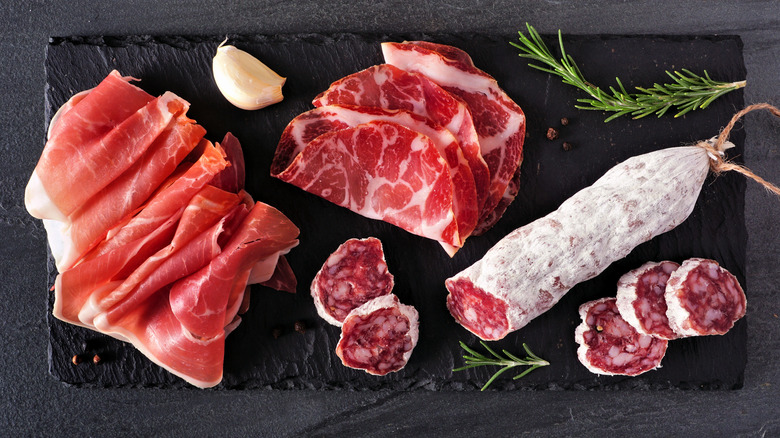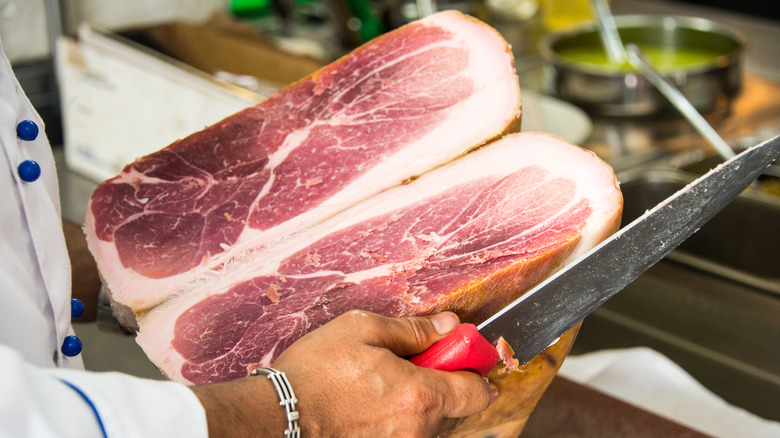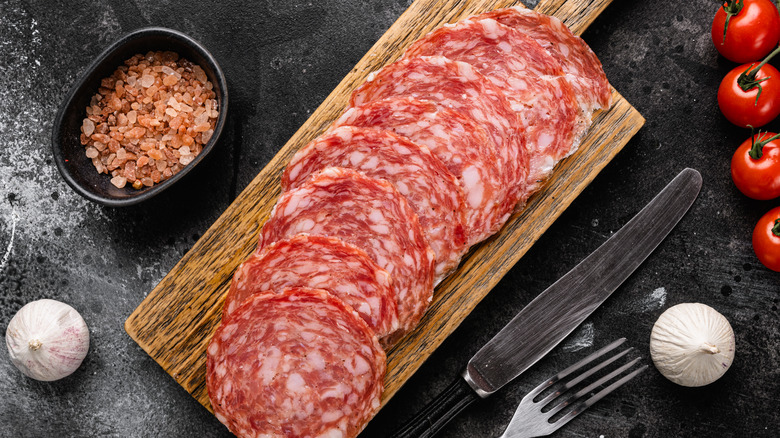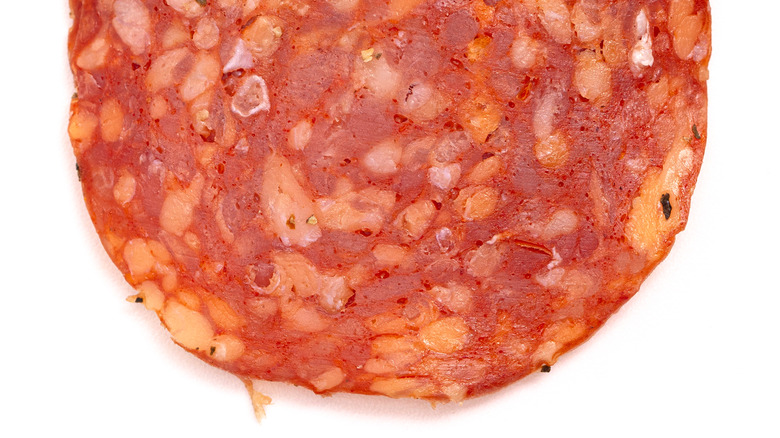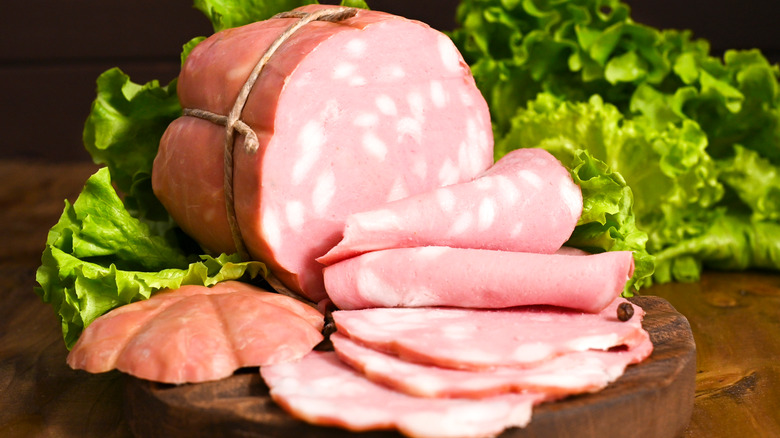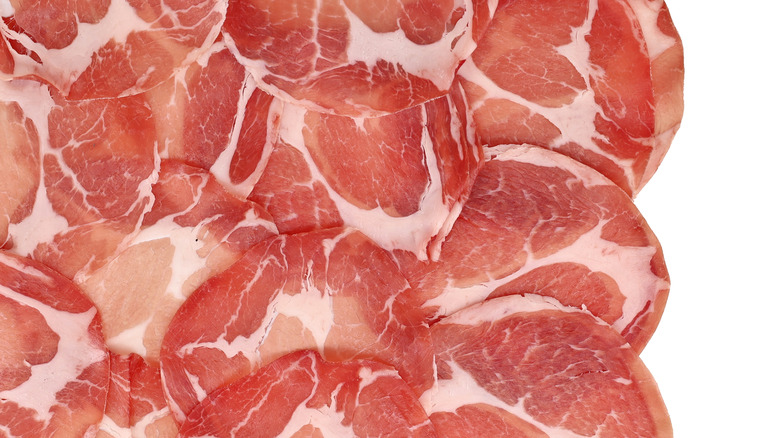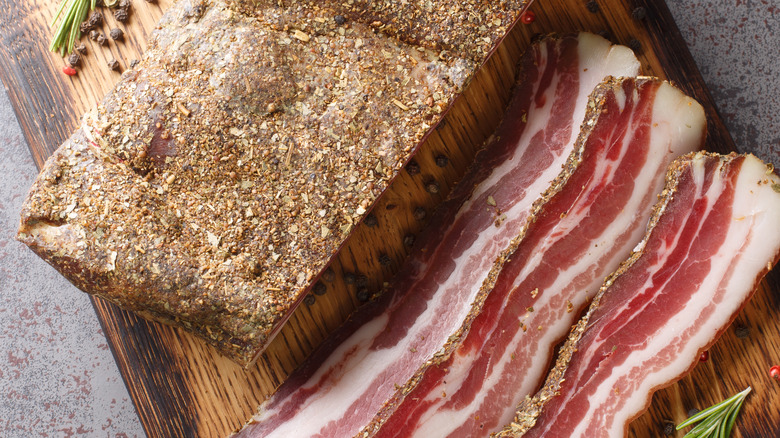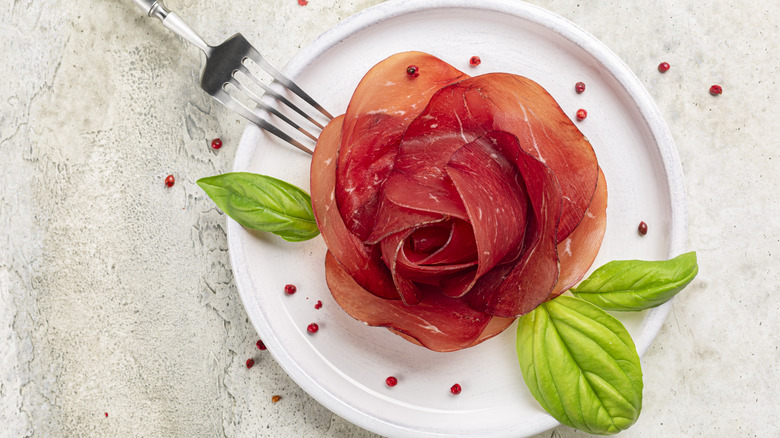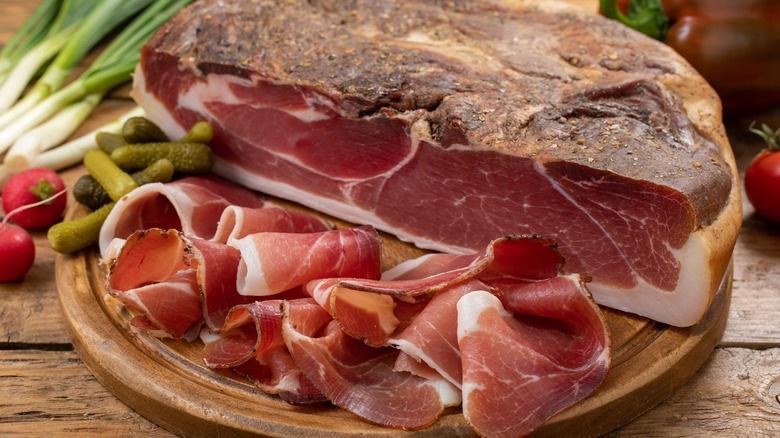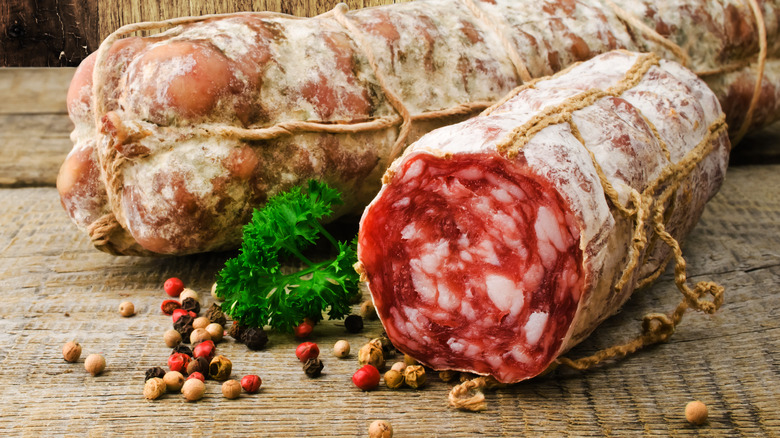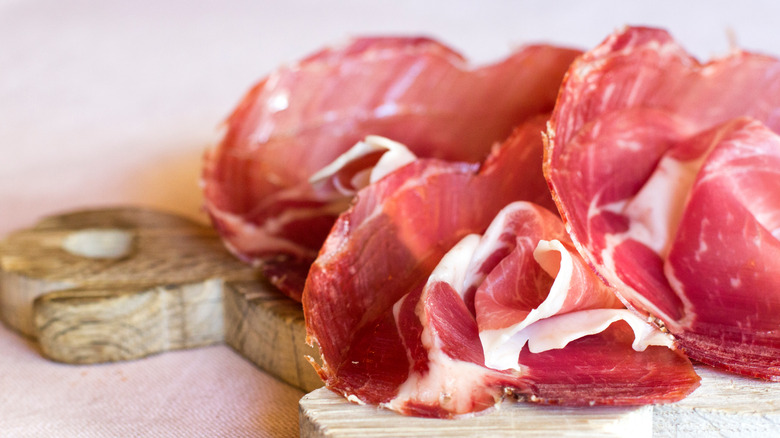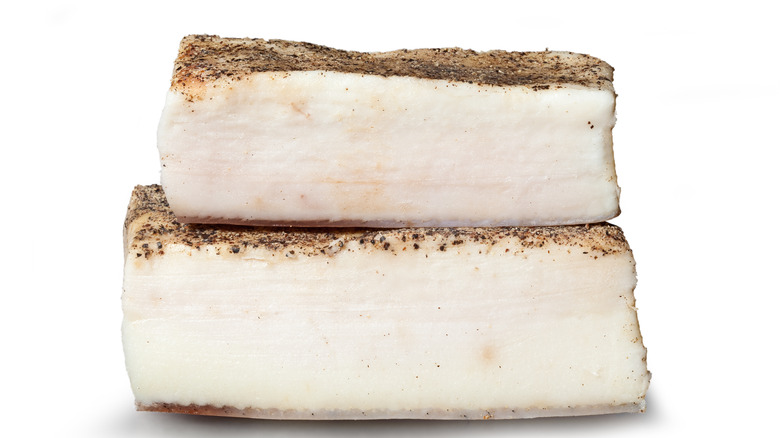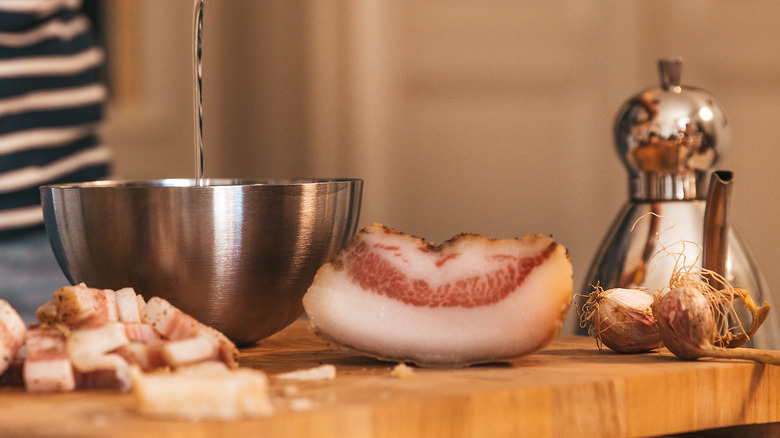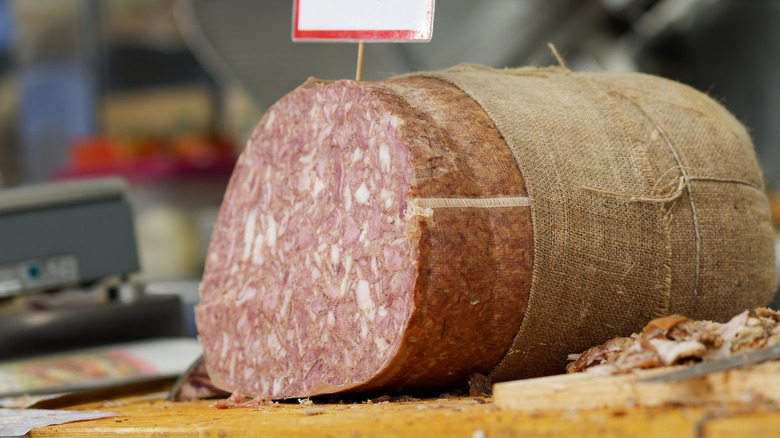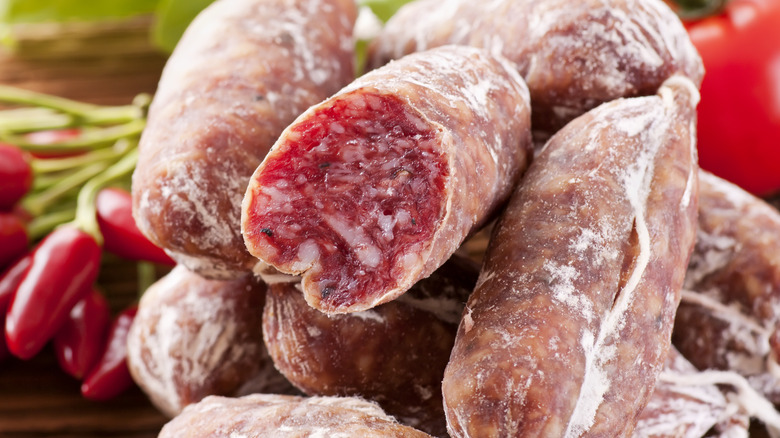15 Italian Deli Meats, Explained
Whisper to many American eaters the phrase "deli meat," and you'll instantly conjure up images of Oscar Meyer bologna or hunks of mass-produced Boar's Head meat. But say the same thing to an Italian, and you're likely to receive a confused look. Italian culinary culture has a long history of producing cured, fermented, smoked, and otherwise preserved meats, but the word root word for this exercise, delicatessen, actually stems from French, then into English. These days, the French may seem to have a monopoly on the entire menu category (we're talking charcuterie,) but many of the best-aged meats you can order from a deli are actually Italian.
Italian deli meats are known as salumi in Europe. Please don't get it confused, however. Despite the name, this meat-mated art form isn't limited to different dried renditions of sausage look-alikes (though there are plenty of them). All across the Mediterranean Boot, various regions have been crafting versions of salt-cured ham, aromatic-brined beef, and, yes, mold-encased salami for generations. Bursting with flavor and unique personalities, the most popular options are probably available at your local butcher today, and ready for you to order.
1. Prosciutto
Prosciutto is a beloved dry-cured ham with exceptional flavor and versatility. Few other Italian deli meats can be considered as classic. Its origins trace back to ancient Italy, where the practice of curing ham dates over 2,000 years.
The heartland of prosciutto production lies in regions like Parma, San Daniele, and Tuscany. Here, the process involves salting the ham and allowing it to rest before undergoing an extended period of air-drying, sometimes taking up to two years. This method imparts prosciutto with its signature tenderness and complex flavor profile, characterized by a harmonious blend of saltiness and umami.
Two prominent types of prosciutto stand out: Prosciutto di Parma and Prosciutto di San Daniele. Prosciutto di Parma, from the Parma region, is renowned for its delicate, slightly sweet taste, while Prosciutto di San Daniele, originating in San Daniele, offers a more robust and nutty taste. Both varieties are protected by a coveted PDO (Protected Designation of Origin) status within the European Union, ensuring that only hams adhering to strict production guidelines can bear the names.
Prosciutto has a range of culinary uses. It is often served thinly sliced as an appetizer or part of a charcuterie board, where its buttery richness envelops cheeses, olives, and crusty bread. Wrapped around fruits like melon or figs, prosciutto's sole seasoning of sea salt adds a bright contrast that marries beautifully to natural sweetness. When cooking, use it to elevate pasta dishes, risotto, and salads.
2. Genoa salami
In Italy, many distinctive types of salami trace their roots to a specific place. The port city of Genoa, located in the Liguria region of Italy, has its own eponymous cured product. The spiced and cured sausage is made from pigs raised around the hills of Genoa, which gives it a specific flavor mirroring the environment and diet they forage from the region.
Crafted from a blend of coarsely ground pork (and sometimes veal), Genoa salami showcases a harmonious balance of flavors. It's seasoned with a medley of spices, including garlic, black pepper, and sometimes red pepper flakes, contributing to its signature taste profile. The meat mixture is carefully wrapped in natural casings and then undergoes an aging and air-drying process that can last months. As a salami, Genoa is fermented, so a mold layer works to preserve the meat.
The flavor of Genoa salami is robust, with savory, garlicky undertones and a subtle spiciness. As it ages, the salami develops complex umami notes and a semi-firm texture that becomes oily when warm. Its versatility is a highlight — Genoa salami is frequently served in antipasto platters but can also be thinly sliced and layered in sandwiches, salads, or pasta.
3. Milano salami
Milano salami is a jewel of Italian cured meats, eaten as frequently on charcuterie boards as it is consumed on sandwiches, in salad and soups, or baked into dishes such as frittata. Hailing from Milan, the capital of Lombardy in Italy, this salami carries a legacy deeply intertwined with the region's culinary traditions.
Like many types of salami, Milan's self-named sausage is meticulously crafted using a blend of ground pork and blended with an array of spices, including garlic, black pepper, and white pepper. The rice-like grind of meat gives the final sausage a smooth texture. Often, Milano salumi has a secret ingredient: the inclusion of white wine. The addition of this tangy ingredient imparts a mildly acidic trait, which helps move the taste of satisfying pork across your palate. Aged within a timeframe between three to nine weeks, the prolonged maturation period allows the flavors to meld and intensify, resulting in a sausage that is both tender and bursting with complex tastes.
In the U.S., you might order this deli salami for a touch of elegance on the plate, though it is known as a popular, well-known workhorse in Italy. Salumi Milanese can take on slightly sweet notes in comparison with other types of salami, isn't too salty, and is not exceptionally oily either. The light to bright red color will definitely inspire some appetite.
4. Calabrese salami
What sets Calabrese-style salami apart is its unmistakable heat. The red pepper flakes, particularly those sourced from the Calabria region, lend an intense spiciness that packs a punch, creating a robust and vibrant flavor profile. The heat is balanced by the savory notes of garlic and other spices, resulting in a sausage that is as forward as it is complex.
Calabrese-style salami is a vibrant and flavorful Italian dry-cured sausage originating from the southern region of Calabria. The composition of Calabrian salami typically includes coarsely ground pork meat decked with red pepper flakes (often Calabrian chili peppers) and a blend of spices such as garlic, paprika, and black pepper. These ingredients impart a vivacious kick and an intense odor to the salami. The meat mixture is then stuffed in natural casings, traditionally made from pig intestines, and allowed to ferment under a layer of mold as most cured salami does.
There are many uses for Calabrese-style salami in your kitchen. It is commonly enjoyed sliced thinly as part of charcuterie boards or antipasto platters, where its fiery character complements milder cheeses and olives. It can also be incorporated into sandwiches, pizzas, and pasta dishes to add a spicy depth of flavor.
5. Mortadella
Mortadella may be a classic and iconic Italian cold cut, but for some, it can be an acquired taste. This delicacy originates from the Emilia-Romagna region of Italy, specifically Bologna, and has a rich history dating back centuries.
Like bologna, mortadella is a type of sausage made from finely ground pork, typically blended with small cubes of pork fat, which gives it a distinct, creamy rhythm. The mixture is seasoned with typical spices but may also include myrtle berries and sometimes pistachios or olives, which contribute to its unique flavor profile. Unlike many other sausages, mortadella is cooked or baked, not air-dried, which sets it apart from other Italian cured meats.
Traditionally enjoyed in thin, translucent slices, either on its own or as part of a charcuterie platter, mortadella is an Italian cultural phenomenon that may be the most American-style deli meat of them all. The olive variety makes an appearance in all sorts of sandwiches, including the New Orleans classic, a muffaletta. It's also a beloved ingredient in an Italian panini, where it's often paired with cheese, tomatoes, and greens. Additionally, mortadella is the star of the famous Mortadella Bologna sandwich, a specialty in the city of Bologna, where the sausage is typically served in a warm roll with various condiments.
6. Coppa/Capicola
In America, capicola is a salumi that has many interchangeable names. You may see it called cappicola, capocollo, or called coppa. If you're Tony Soprano, you may know it as gabagool. Not only does it have multiple titles, but its origin is divided as well. Some say it comes from Italy's north, around Piacenza. Other histories place capicola from the country's southern regions, particularly Campania and Calabria.
Capicola is made most often from pork shoulder or neck. The meat is first given a mixture of salt, red pepper flakes, black pepper, and other spices. These seasonings give capicola its signature spicy and fragrant flavor. Afterward, the meat is carefully rolled into a cylindrical shape and tied with string, creating its characteristic streaky appearance.
In Italy, the truth about capicola is that its many personalities actually are separate things. Italian capicola (or capocollo) is a cooked pork product that's thinly sliced and more similar to roasted deli ham. The dry-cured sausage that's typical of Italian salumi is specifically and exclusively referred to as copa. Either option is going to provide an authentic taste, but the distinction is clear. Order capicola by any name at an Italian-American butcher, and more likely than not, you will be given an aged meat known for melt-in-the-mouth texture and marbled fat.
7. Pancetta
Pancetta is an Italian cured pork product that's often considered the country's answer to bacon. It's also made from pork belly, but pancetta is different from bacon in that it is typically not smoked. Pancetta is instead cured with salt and a blend of spices like black pepper, garlic, and sometimes fennel, juniper, or red pepper flakes, depending on the (many) regional variations.
Pancetta comes in two main forms: arrotolata and tesa. Arrotolata is rolled into a tubular shape and is the most common variety. Tesa, on the other hand, is flat and resembles traditional bacon strips. Both varieties are widely used in Italian cuisine and beyond.
The preparation of pancetta arrotolata involves rolling the seasoned pork belly into a tight cylinder, tying it with string, and then allowing it to air-dry for several weeks to several months. This aging process develops its flavor and creates its signature texture – firm yet tender. Prior to salting, the pork belly is brined, which is the point at which much of the seasoning is infused. Pancetta tastes like bacon in that it is luxurious and homely, fatty, savory, and salty. However, it's decidedly more complex than its American counterpart and often holds more weight as a culinary ingredient.
8. Bresaola
Bresaola differs from many other Italian deli meat in that it's mostly made from beef rather than pork. Bresaola can taste slightly sweet and a bit musky with a lean, tender, and intensely flavourful profile that carries the mineral character of cattle and unique undertones specific to where it was made.
With that in mind, you should know that not all bresaola is created equal. Although beef (normally sirloin or eye of round) is most prominently used, some regions boast cured pork or horse meat as the main component for their bresaola. To ensure you're getting the highest quality beef, look for Bresaola della Valtellina, which has a Protected Designation of Origin (PDO).
To create bresaola, lean cuts of beef are trimmed of excess fat by expert artisans. Each piece is then flavored with a mixture of salt, black pepper, and whatever other regional flavorings are to be added. Sometimes, it may be wine; other times, vibrant seasonings. Bresaola is air-dried under intensely managed temperature controls for several weeks to several months. This meticulous process results in a deep red, near purple color and a dry, firm texture. It's traditional to eat bresaola with butter and rye bread, but it makes a fine swap anywhere you'd use prosciutto.
9. Speck
Many of Italy's treasured deli meats have a distinct influence from neighboring countries. Speck is a unique case in that regard. It hails from the northern regions of Italy, particularly South Tyrol, a predominantly German-speaking area known as Alto Adige in Italian. Not only is the name speck Germanic, but the preparation process is closer to Northern European than with many other Italian meats.
Like prosciutto, speck is crafted specifically from the hind leg of the pig, which is salt-cured and paired with a blend of spices such as juniper, garlic, and a mix of aromatic herbs. The spice mixture varies from producer to producer, contributing to subtle regional differences in flavor. Speck Alto Adige has a PDO for its unique production. After the initial rub of seasoning, the ham undergoes a slow smoking process. Speck is air-dried in the fresh Tyrol air, allowing it to develop accents that echo back to the alpine mountain tops.
The result is a marbled, ruby-red, and flavorful ham with a delicious blend of savory, smoky, and slightly spicy notes. It's darker brown in color and has a harder texture than prosciutto. Speck does not become as greasy (it will get oily when warm). It has a harder edge even when cut thin. While great on a charcuterie board, consider doing as the Tyroleans do and chop your speck into thick chunks that can be simmered into soup or stew.
10. Soppressata
Soppressata salumi can be found all over Italy, with many notable varieties coming from the middle and southern regions especially. In Tuscany, there is even a variety that uses pork tongues. There are two primary things that make soppressata special: it's a very coarsely textured sausage, and despite the vast range of unique expressions, most variations have the fiery and passionate character that Italians are known for.
Soppressata is typically made from pork meat — but the meat isn't ground. Instead, it has to be roughly chopped with a knife to ensure the inconsistent texture. The inclusion of red pepper flakes within a standard seasoning is key to its spicy kick.
The meat mixture is traditionally stuffed into natural casings, usually pig intestines, and allowed to air-dry and age for around 40 days. During this process, the sausage will become more firm but never dense; the texture is typically tender, slightly chewy, and lubricious. The flavor of soppressata is bold and spicy, with a savory, garlicky depth and a hint of heat from the red pepper flakes. While you certainly can cook with soppressata, it's recommended to eat it as is with cheese, olives, fruit, and rustic bread.
11. Culatello
Culatello is the type of Italian deli meat that can be hard to justify spending on, especially in a day and age where the cost of food is a permanent discussion. Still, if you happen to see this meat while shopping, grab it. You may never be standing so close to royalty again.
Considered the king of Italian charcuterie because of its meticulous preparation, culatello is an Italian ham specifically from the areas surrounding the town of Zibello, near Parma. Just like its famous cousin, culatello is made from a pig's hind leg. However, the process for making culatello is more selective, using only the best, most marbled part known as the culatta. The seasoned meat is encased in a pig's bladder, which allows it to have a lengthy and precise aging process.
The aging of culatello is what truly distinguishes it. The hams are hung in cool, well-ventilated cellars for a minimum of 12 months. It turns out nature plays a part in the curing process as well. The cellars are inundated by fog from the nearby Po River year-round, which keeps things especially cool and moist underground. The resulting flavor is hyper-localized, and the extended time curing fosters a ham that is incredibly silky with a deep, earthy taste and sweet and savory highlights.
Culatello is typically cut into paper-thin slices and served in ways that showcase its exquisite marbling and nuanced flavors. Its unparalleled quality has earned it a special place in Italian and international gastronomy.
12. Lardo
Some deli meats are made for sustenance. Others are pure decadence. Lardo is the latter. To create lardo, thin layers of pork fatback are crusted with a blend of salt, pepper, herbs, and sometimes garlic or rosemary. These seasonings are applied generously to the fat, which is then left to cure for several months. During this time, the cap undergoes a transformation, becoming tender and infused with the flavors of the seasonings. As a result, lardo tastes like the unctuous bite of your dreams.
Lardo is distinct from other cured meats in that it is not made from muscle but rather from pure pork fat. The result is a silky, ivory-white, translucent product with a texture that melts effortlessly on the tongue. Often, you'll find lardo being served paper-thin, allowing its delicate, creamy texture to shine. Another common way to enjoy it is as an accompaniment to crusty bread, often with a drizzle of high-quality olive oil and a sprinkle of sea salt. It's also a popular ingredient where it can be used to flavor pasta dishes, roasted meats, and even pizza.
Despite its popularity, you should never cook with lardo. It is possible to render it down like regular pork belly or lard, but you'll miss much of the nuance along the way.
13. Guanciale
Guanciale is a traditional Italian cured meat made from the jowl or cheek of the pig, specifically the cheeks near the jawline. It is celebrated for its intense pork flavor and unique texture, setting it apart from other comparative Italian cured meats, like pancetta.
Both are fatty pieces of salumi, but the primary difference between guanciale and pancetta lies in the cut of meat used and the preparation. While pancetta is made from pork belly, guanciale is prepared using cheek meat. Surprisingly, the cheek contains a higher proportion of fat and a more intense flavor. Guanciale's texture is also distinguished. It's firm yet slightly yielding, with marbled streaks running through the meat, which, when rendered during cooking, contributes to the luscious creaminess.
Hungry eaters need only look as far as the Roman staple spaghetti alla carbonara. Guanciale is essential to the make-up of this dish, where it's diced and sautéed for succulent flavor.
14. Finocchiona
Finocchiona is a Tuscan salami known for its infusion of a special seed that imparts a unique flavor and aroma. The name finocchiona is derived from finocchio, which means "fennel" in Italian. Overall, this garden spice is the defining ingredient of the salami: fennel seeds not only contribute to the salami's distinct taste but also provide a subtle crunch in each bite.
Finocchiona is made from coarsely ground pork meat. This mix is typically a blend of lean cuts and fat seasoned with your typical roster of salt, black pepper, garlic, and, of course, fennel seeds. It is left to undergo an aging process that can range from a few months to over a year. The natural casing will become mold-covered during this time, the flavors intensify, and the salami develops its characteristic mouthfeel, which is tender yet slightly chewy. In Tuscany, it's often served in large portions. Because of the licorice-like notes that are given off by the fennel, cooking with finocchiona salumi needs to be a careful consideration. It won't match every single dish, but is always a great stand-alone addition to antipasti plates.
15. Cacciatorini
Cacciatorini salami, often referred to as cacciatorini or simply cacciatore, is a type of Italian dry-cured sausage typically made from rough-chopped pork meat, although blends with other meats can be found. What sets cacciatorini apart is its small size, typically around 6-8 inches in length and less than an inch around. The name cacciatorini means "little hunters" in Italian, suggesting a historical use as a portable, convenient snack for hunters and travelers.
The sausage is brightened with a blend of spices, but the most prominent inclusion in the salami's make-up is red wine, salt, and garlic. Salt and wine are particularly important to this Italian deli meat as it has a relatively short curing time (up to three weeks), and these two ingredients contribute to preventing the growth of harmful bacteria during that time. If you've ever considered making your own salami, then cacciatorini is the way to start. The agrarian history makes it accessible for first-timers.
